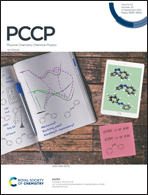31P nuclear spin singlet lifetimes in a system with switchable magnetic inequivalence: experiment and simulation†
Abstract
31P NMR spectroscopy and the study of nuclear spin singlet relaxation phenomena are of interest in particular due to the importance of phosphorus-containing compounds in physiology. We report the generation and measurement of relaxation of 31P singlet order in a chemically equivalent but magnetically inequivalent case. Nuclear magnetic resonance singlet state lifetimes of 31P pairs have heretofore not been reported. Couplings between 1H and 31P nuclei lead to magnetic inequivalence and serve as a mechanism of singlet state population conversion within this molecule. We show that in this molecule singlet relaxation occurs at a rate significantly faster than spin–lattice relaxation, and that anticorrelated chemical shift anisotropy can account for this observation. Calculations of this mechanism, with the help of molecular dynamics simulations and ab initio calculations, provide excellent agreement with the experimental findings. This study could provide guidance for the study of 31P singlets within other compounds, including biomolecules.



 Please wait while we load your content...
Please wait while we load your content...
